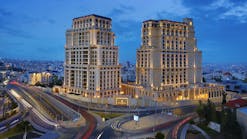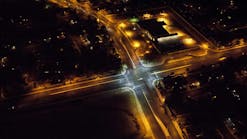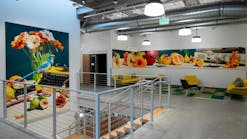The lighting design firm Domingo Gonzalez Associates (DGA) headed up the project for lighting all public areas inside the terminal and the arrival and departure areas outside. Firm president Domingo Gonzalez said, “The main challenge revolved around the requirements of designing the first LEED Silver certified building at the Hartsfield-Jackson Atlanta International Airport, and executing this with lighting strategies and technologies that were program responsive, energy efficient, cost effective and easy to maintain.”
With energy efficiency a key goal, one might expect that LED-based lighting was a natural choice, but DGA didn’t specify LEDs. Gonzalez explained that the design work began over four years ago when LED products were considered too expensive, and the number of commercially viable options was still limited.
Ticketing hall
Getting back to the main ticketing hall (pictured on the cover and nearby), the DGA design team used single-lamp Mark Architectural Lighting (an Acuity Brand) Slot 6 fixtures to form what appear to be continuous linear lights stretching to as much as 24 ft. Running perpendicular to those lights, the team installed custom-made cove fixtures with deep-blue Osram Sylvania T5 fluorescent tubes.
Mark manufactured the cove fixtures based on the lighting firm’s specification. Nancy Lok of DGA developed an adaptable, staggered-lamp approach to ensure a seamless line and indeed the lighting appears continuous across the width of the hall.
That brings the discussion to controls used in the ticketing hall and elsewhere in the facility. The design implements programmatic controls that can reduce light levels based on the time of day. It also includes controls that work based on occupancy sensors and on photocells that can sense daylight levels.
Gonzalez explained that the controls approach was important for both saving energy and reducing maintenance costs on the airport project. He said, “The lamp with the longest life is the one that is not on.” The controls used in the airport are relatively simple. Gonzalez described them as “hardly sophisticated but very effective.” The incremental granularity of the control is a single circuit that powers multiple fixtures as opposed to individual fixture control that you could get with technology such as Digital Addressable Lighting Interface (DALI). The design uses control products from the Acuity’s Synergy and Lighting Control & Design (LC&D) divisions.
The controls are utilized in a number of ways. For example in the main hall discussed previously, there are MH uplights for indirect lighting that are mounted on the columns along the outer walls of the hall. Those lights are intended to be turned off during daylight hours, as are the custom blue fluorescent lights.
No dimming required
In other areas such as the departure concourse, the design mixes fluorescent fixtures, compact-fluorescent downlights, and MH sources. Light levels are controlled by turning some select lights off, and in some cases via the use of Hi/Lo ballasts than can drive a fluorescent lamp at either 50% or 100% of full output. No true dimming technology is utilized, in terms of dimmable ballasts or lamps. Instead, a switching approach was selected in response to owner preferences for maintenance simplicity, intuitive operating experience, and for flexibility in terms of low cost.
Likewise, controls come into play in the security checkpoint areas. When checkpoints are open, the system delivers 40 fc of light. At night after 11:00 PM, that level can be dropped to 10 fc.
In the Immigration and Naturalization Service (INS) or customs area, the airport required higher light levels for custom agents. In that area, DGA specified MH downlights integrated with the Mark Fluorescent Slot fixtures. The team sought in each case to match the specified fixtures to the localized need.
Outdoor lighting
In the outdoor areas, DGA again used a combination of MH lamps and fluorescent fixtures. The upper-level departure area relies primarily on MH downlights that are mounted in the canopy. Underneath the departure roadway in the arrivals area, the team used a mix of Lithonia I-Beam fluorescent fixtures and MH fixtures.
The access roadway was not in DGA’s scope of work. According to Acuity, the roadways feature circular Omero fixtures from Lithonia. The company supplies those fixtures with the option of MH, high-pressure sodium (HPS), induction, and compact-fluorescent lamps, although the airport utilized the MH option.
In some cases MH lamps are approaching the efficacy of LED lighting (see page 22). The MH lamps installed at the Atlanta airport come close with an efficacy of 86 lm/W, according to Russ Walter of lighting distributor Lighting Associates, which supplied the fixtures. The access roadway lighting does not include the use of adaptive controls for dimming late at night because there is traffic on those roadways all night long.
LEED features
The rainwater collection system can store 25,000 ft3 of water including roof runoff. That water is filtered before it’s returned to the local watershed.
The plumbing system uses low-flow fixtures that are projected to save 40,000 gallons of water annually. Moreover, the terminal design included highly efficient heating and cooling systems.











